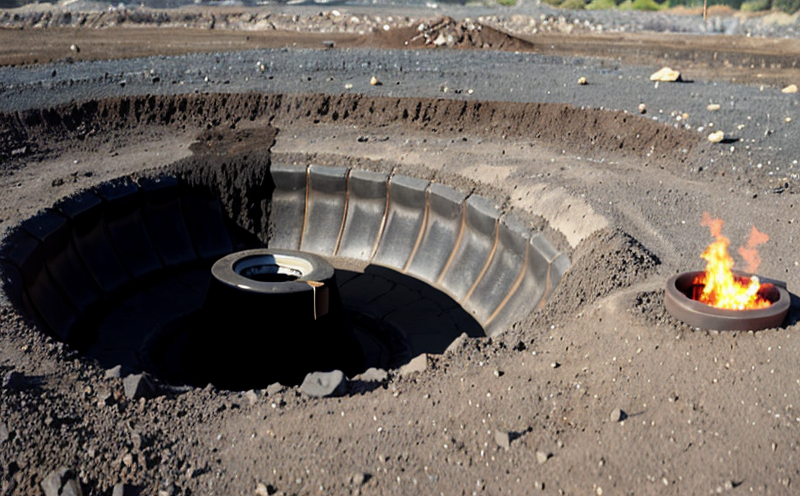ASTM D5373 Carbon Hydrogen Nitrogen Analysis in Coal Testing
The ASTM D5373 test method is a critical standard used to determine the carbon, hydrogen, and nitrogen content of coal samples. This analysis plays a pivotal role in ensuring that coal meets the specified quality standards required by industries such as power generation, steel manufacturing, and chemical production.
Carbon, hydrogen, and nitrogen are essential components of coal, influencing its calorific value, ash content, and other properties that directly impact its usability. By accurately measuring these elements, ASTM D5373 helps ensure the consistency and reliability of coal quality across various applications. This method is widely used in quality control departments to monitor the composition of raw materials before they are processed or sold.
The test involves several steps: sample preparation, combustion analysis, and calculation of results. The sample must be carefully weighed and placed into a furnace where it undergoes complete combustion. During this process, the volatiles are driven off, leaving behind only the fixed carbon. After combustion, the gases produced are passed through various absorbents which trap the different components (carbon dioxide for carbon, water vapor for hydrogen, and nitrogen oxides for nitrogen). The amounts of these gases are then measured using appropriate analytical techniques.
The accuracy of ASTM D5373 is paramount in maintaining compliance with international standards such as ISO 10962-1. These standards ensure that the testing procedures are consistent across different laboratories, thereby providing a reliable basis for quality assurance and regulatory compliance.
For industries relying heavily on coal, understanding these elemental compositions allows them to optimize processes, enhance product quality, and reduce waste. For example, power plants can better manage fuel efficiency, while steel manufacturers can tailor their production methods to suit the properties of the coal they use.
- Power Generation: Ensures optimal combustion for maximum energy output.
- Steel Manufacturing: Adjusts furnace conditions based on coal characteristics to improve product quality and reduce emissions.
- Chemical Production: Optimizes feedstock selection and process efficiency for better yields.
- Emissions Control: Helps in meeting environmental regulations by providing data needed for emission reduction strategies.
- R&D: Supports innovation by facilitating the development of new products or processes that require precise coal composition knowledge.
- Procurement: Enables informed decisions regarding suppliers and material specifications.
In conclusion, ASTM D5373 is not just a technical procedure; it’s a cornerstone for ensuring product quality, operational efficiency, and environmental responsibility within the mining sector. By adhering to this standard, companies can enhance their competitiveness in an increasingly regulated market environment.
Why It Matters
The importance of ASTM D5373 cannot be overstated, especially for industries that depend heavily on coal quality. Accurate carbon, hydrogen, and nitrogen content analysis is crucial for several reasons:
- Quality Control: Ensures that the coal meets specified standards before it enters processing or production.
- Cost Efficiency: Helps in optimizing fuel usage, thereby reducing operational costs.
- Emissions Management: Provides data for implementing strategies to minimize harmful emissions.
- Product Consistency: Ensures that the coal used in various processes performs consistently across different applications.
- Regulatory Compliance: Helps companies stay within legal and environmental guidelines, avoiding potential fines and penalties.
- Sustainability Initiatives: Supports efforts to reduce carbon footprints by providing insights into the most efficient use of coal resources.
In summary, ASTM D5373 is essential for maintaining high standards of product quality and operational efficiency. It ensures that coal meets not only internal specifications but also external regulatory requirements, contributing significantly to sustainable practices in mining and related industries.
Scope and Methodology
The scope of ASTM D5373 is confined to the determination of carbon, hydrogen, and nitrogen contents in coal samples. This test method is applicable to both raw and processed coal products intended for various industrial uses. The methodology involves precise sample preparation, combustion analysis, and subsequent calculation of the elemental composition.
Sample Preparation: A representative sample of approximately 1 gram is weighed accurately and placed into a furnace. Prior to placing the sample in the furnace, it undergoes thorough drying at specified temperatures to remove any moisture content. This step ensures accurate measurements by preventing the dilution effect caused by water vapor.
Combustion Analysis: The sample is then subjected to complete combustion in an oxygen-rich environment within the furnace. During this process, volatiles are driven off, leaving behind only the fixed carbon. The gases produced as a result of this combustion are collected and passed through various absorbents designed specifically for capturing CO₂ (carbon dioxide), H₂O (water vapor), and NOₓ (nitrogen oxides).
Calculation: Once the gases have been absorbed, they are quantified using appropriate analytical techniques such as infrared spectroscopy or gas chromatography. The amounts of these gases are then converted into percentages by weight to represent the carbon, hydrogen, and nitrogen contents in the coal sample.
The precision and accuracy of ASTM D5373 rely heavily on standardized procedures and equipment. Compliance with international standards like ISO 10962-1 ensures that results obtained from different laboratories are comparable, fostering trust among stakeholders.
Industry Applications
The application of ASTM D5373 extends beyond the mining sector into numerous industries where coal plays a significant role. Here are some key areas:
- Power Generation: Ensures that fuels used in power plants meet the required specifications for efficient combustion and maximum energy output.
- Steel Manufacturing: Provides data necessary for adjusting furnace conditions to enhance product quality and reduce emissions.
- Chemical Production: Supports the development of new products or processes by providing precise coal composition knowledge.
- Emissions Control: Assists in implementing strategies aimed at reducing harmful emissions, thus contributing to environmental protection.
- R&D: Facilitates innovation through detailed analysis of coal samples used in research and development activities.
- Procurement: Enables informed decisions regarding suppliers and material specifications based on the quality parameters set by ASTM D5373.
These applications underscore the versatility and importance of ASTM D5373 within various sectors. By leveraging this standard, companies can achieve operational excellence while adhering to stringent environmental regulations.





